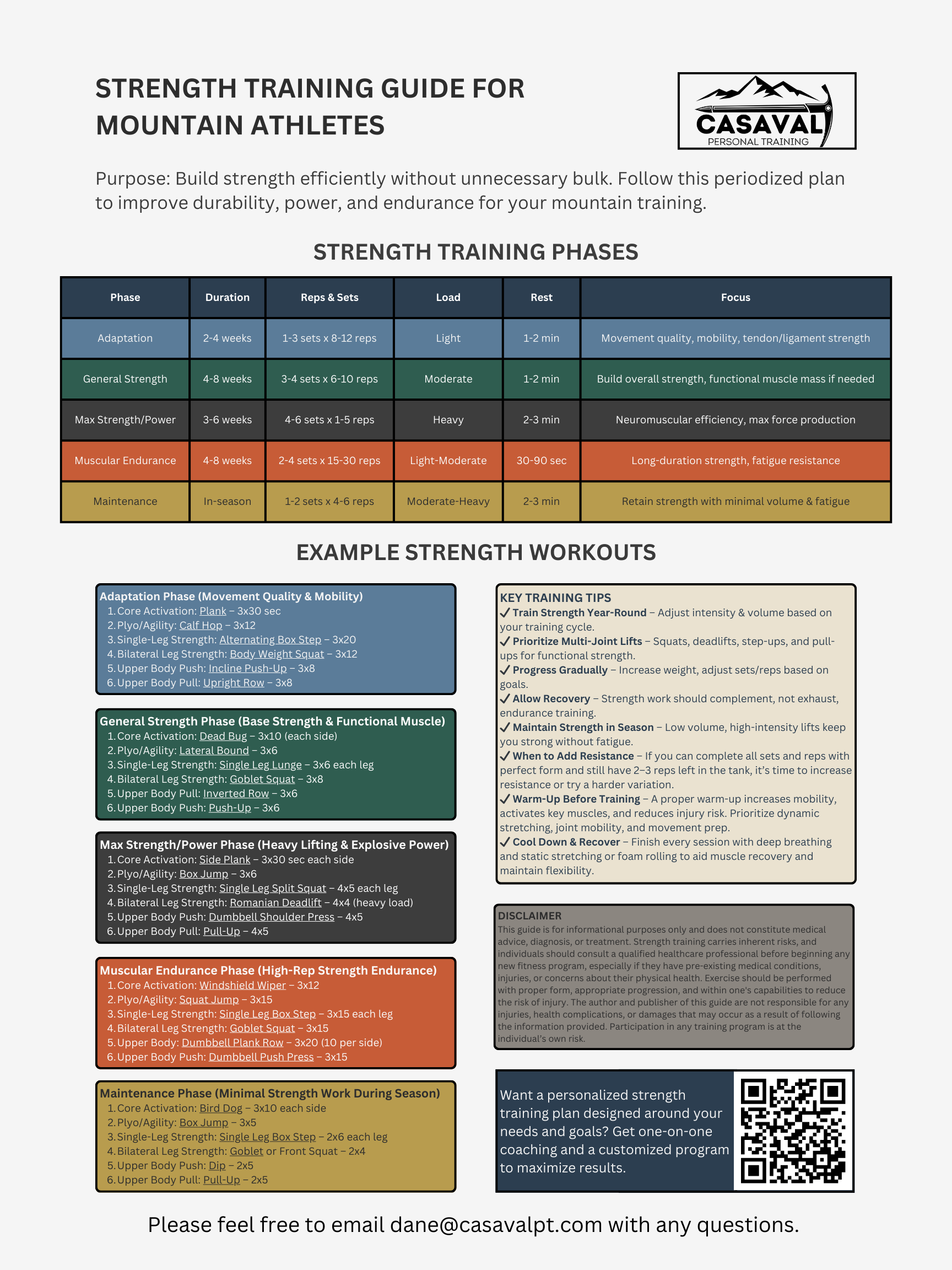Strength Training for Mountain Endurance Athletes
Mountain endurance athletes—whether mountaineers, climbers, ski mountaineers, or trail runners—face unique physical demands that require a thoughtful approach to strength training. Unlike bodybuilders, mountain athletes need strength that improves durability, efficiency, and power without unnecessary bulk.
Leading coaches like Nick Grantham and Scott Johnston, as well as organizations such as ISSA and ACSM, emphasize a periodized strength approach to achieve this. The goal is to train the right adaptations at the right time, maximizing strength gains while minimizing fatigue and interference with endurance training.
Below is a breakdown of the key strength training phases that mountain endurance athletes can follow, ensuring long-term strength progression without compromising endurance performance.
As you integrate this into your strength program, keep a few key principles in mind:
Choose exercises that reinforce the movement patterns of your sport. Your strength work should support, not compete with, your endurance training.
Start with easier variations and limited range of motion. Master control and technique before progressing to full-range, more demanding exercises.
Space out your strength sessions by two or three days. This helps maintain the quality of your endurance training. Two days between sessions is usually enough to recover while keeping plenty of energy for your hikes, runs, and climbs.
The Five Strength Training Phases
Adaptation/Transition Phase (2–4 Weeks)
Purpose: Establishes movement quality, mobility, and neuromuscular coordination. Prepares tendons, ligaments, and stabilizers for heavier work ahead.
Training Focus:
Light loads, higher repetitions (8–12+ per set) with a focus on movement quality
Bodyweight and foundational lifts such as squats, lunges, step-ups, and push-ups
Slow, controlled tempo to reinforce proper technique
Moderate rest periods (1–2 minutes between sets)
Why It Matters:
Most strength gains in this phase come from neuromuscular adaptations—improved coordination between the brain and muscles. This phase reduces injury risk and lays a foundation for more intense strength work.
General Strength Phase (4–8 Weeks)
Purpose: Builds a base level of strength while developing functional muscle mass if needed. This phase solidifies fundamental strength before progressing to heavier lifting.
Training Focus:
Moderate weight, moderate repetitions (6–10 reps per set)
Emphasis on compound movements: squats, deadlifts, step-ups, rows, and pull-ups
Rest periods of 1–2 minutes between sets to allow for strength development
Moderate lifting tempo with a focus on controlled movement
Key Considerations:
Athletes who are underweight or underpowered may benefit from a slightly higher volume of work to build functional muscle mass, while heavier athletes should focus on strength gains without excessive hypertrophy to avoid unnecessary weight gain.
Maximum Strength & Power Phase (3–6 Weeks)
Purpose: Develops neuromuscular efficiency by training the body to produce maximum force with minimal muscle fatigue. This phase enhances strength-to-weight ratio, making movement more efficient.
Training Focus:
Heavy resistance, lower repetitions (1–5 reps per set)
Longer rest periods (2–3+ minutes) to allow full recovery
Focus on high-intensity, low-volume compound lifts such as squats, box steps, and weighted pull-ups and/or dips
Explosive power work, such as plyometric jumps or short, steep hill sprints
Why It Matters:
Strength gains in this phase are largely neurological, meaning the body becomes better at recruiting muscle fibers efficiently. This leads to improved movement economy, helping endurance athletes perform at high intensities with reduced effort.
Muscular Endurance Phase (4–8 Weeks)
Purpose: Converts strength gains into strength endurance, ensuring muscles can sustain repeated contractions over long durations without excessive fatigue.
Training Focus:
High repetitions (15–30+ reps per set) or extended-duration exercises
Short rest periods (30–90 seconds) to build local muscular endurance
Long sets of weighted step-ups, sustained uphill hiking with a pack, or circuit training
Gradual integration of more sport-specific endurance movements
Why It Matters:
Mountain sports require sustained strength over long efforts, not just raw power. This phase enhances fatigue resistance, making ascents, technical climbs, and long endurance events more efficient.
Maintenance Phase (In-Season Strength Work)
Purpose: Preserves gains in strength and power while allowing endurance training and sports to take priority. Strength work is reduced to the minimum effective dose.
Training Focus:
Lower frequency (1–2 short sessions per week)
Moderate to heavy weight with low volume (2–5 reps per set)
Prioritization of essential compound movements with minimal accessory work
Long rest periods (2–3+ minutes) to prevent fatigue from interfering with endurance training
Why It Matters:
Strength gains can be maintained with minimal work, as long as intensity remains high. This prevents the loss of neuromuscular adaptations while allowing full focus on endurance efforts.
Integrating Strength Training Without Compromising Endurance
Strength training should complement, not compete with endurance work. To achieve this balance:
Train in phases to ensure the right adaptations at the right time.
Prioritize multi-joint, functional exercises over isolated bodybuilding-style workouts.
Adjust strength frequency based on your endurance workload—more lifting in base periods, less in peak endurance training.
Progress gradually by increasing resistance when sets feel too easy while maintaining good form.
By following this phased approach, mountain athletes can build strength that directly enhances performance without excessive fatigue or weight gain.
Get the Full Strength Training Guide
To make this system easy to follow, I’ve put together a Strength Training Guide for Mountain Athletes, detailing workouts, progressions, and key training tips in a structured format. Tap below to download the guide for free.
Final Thoughts
Strength training is sometimes underutilized or misapplied for mountain endurance athletes. When applied correctly, it leads to greater resilience, efficiency, and power in your endurance training and in the mountains.
By following a structured approach, you can maximize strength gains while ensuring your endurance performance continues to improve.
If you’re serious about getting stronger for the mountains, download the Strength Training Guide for Mountain Athletes and start implementing these phases today.
If you’re looking for a customized strength & endurance plan based on your specific goals, consider one-on-one coaching to help structure your strength and endurance work efficiently.


